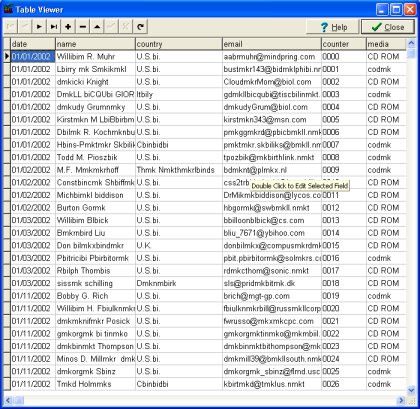Good Facts To Selecting An Email List Website
Good Facts To Selecting An Email List Website
Blog Article
What Should I Consider Before Purchasing An Cpa Email List?
It's important to consider several factors when purchasing the CPA email list. This will ensure that the list you buy is of high quality, in compliance with legal requirements and applicable to your company's goals. What to look for: 1. Quality of data and accuracy
Source of information: Examine the sources of the lists. Most reliable providers collect their information from reliable sources including trade associations, directories of professionals, databases. Avoid lists created using scraping and other unreliable methods since they could contain inaccurate or outdated information.
Verification: Ensure that the list of email addresses has recently been verified. This reduces bounce rates and makes sure you're reaching valid, active email addresses. Find out how often the list is cleaned and updated because CPAs are often changing firms or positions.
Segmentation and Filters Segmentation and Filters: A CPA list that is useful should include options such as segmentation by the location (city or state, or even country) or specialization in a particular industry (e.g. taxation, auditing and financial planning), experiences years, size of the firm and so on. These elements can be utilized to enhance the effectiveness of marketing campaigns, allowing more targeted targeting.
2. Legal Regulations
Data Privacy Laws: Ensure that the email list is compliant with the laws on data protection such as the General Data Protection Regulation (GDPR), the California Consumer Privacy Act (CCPA), and any other relevant local regulations. Lists must only contain emails obtained legally.
Compliance with CAN-SPAM Act: In the case of U.S. email campaigns, the list must be in compliance with the CAN-SPAM Act, that governs commercial email communications. This includes opt-out features and the avoidance of misleading subjects or content. Non-compliance could lead to fines or legal issues.
Sign up for Consent. Be sure to obtain email addresses through opt-in permission, i.e. recipients agreeing to receive emails. This reduces the chance of receiving spam complaints and boost engagement.
3. Provider Reputation
Reputable Provider: Study the provider's reputation in depth. To gauge the experience of past clients, read reviews, case studies, and testimonials. Companies with an established track history are more likely to provide reliable and accurate information.
Transparency. The provider should be clear about when and how the data is changed. It's a red flag if the provider can't be able to clearly explain their methodology.
Customer Support: Dependable customer support is crucial for those who need assistance with list customization, troubleshooting, or understanding the rules of compliance. A good support system can help you save time and energy during the course of your campaign.
4. Cost and Return on Investment
Pricing Models: Different companies provide different pricing models. Some charge per customer, whereas others require are a flat fee or a subscription. Examine ROI expectations against costs and balance the price and quality of the list.
Find out about the refund policy. If there is a large number incorrect or inactive email addresses, many companies offer a replacement or refund policy. A guarantee can provide you with peace of mind.
Price compares to. value: don't concentrate on the price. If the list isn't of good quality, a list with a lower price may look appealing but may result in low engagement rates or high bounce rate. You should pay for lists that give quality through accuracy of data and segmentation choices.
5. Data Ownership and Usage
Single-Use vs. Multiple-Use: Determine if you're purchasing the list only for a single use or when you own the list and are able to use it for ongoing campaigns. Although mailing lists for single-use are more expensive and you'll have more freedom when it comes to long-term campaigns if own the list.
Shared lists: Find out if your list of email addresses is private or shared. Shared Lists: Determine if the email list is exclusive to you or shared with multiple buyers. Shared lists can lead to people becoming exhausted if they've received lots of marketing emails.
6. Data Integration and Format
CRM compatibility: Check that the email list that you receive is in format that is compatible with your email CRM or marketing software. Examples include CSV and Excel. It allows easy importation and managing your data.
Simple to use: How easily can the information be segmented or managed after they have been in your system? An organized database will help enable targeting and personalization to be more efficient.
7. Ethical concerns
Relevance and the value of content: Because CPAs work hard and are a lot of work, it is crucial to send out content that is both relevant and useful. Sending irrelevant messages may damage your brand's image or increase spam complaints.
Avoid over-emailing: Be aware of the frequency with which you send emails to those on your list. Unsubscriptions could result in unsubscribes or spam complaints that can damage your sender's reputation.
Also, you can read our conclusion.
If you're considering purchasing an CPA mailing list, be sure that you prioritize the data's quality and compliance with the legal requirements, as well as the reputation of your provider. This will ensure that the list is worth the investment. Segmentation and targeting as well as ethical practices will increase engagement, ROI, as well as image of the brand. Check out the best cpa email list for website guide.
Be Aware Of These 10 Aspects When Buying An Natural Gas And Oil Email List.
When buying an email list for the oil and gas industry it's important to consider several factors to make sure the list is top-quality focused, precise, and legally in compliance. These are the top 10 things to think about:
1. Relevance of the Target Audience
Concentrate on industry: Make sure that the list of email addresses is aimed at the oil and gas industry. Lists should be segmented so that they include professionals such as engineers, geologists and managers of operations in the upstream, middlestream and downstream.
Look for the job titles and roles that include the right individuals within the company you want to target (executives or managers, engineers). You can target specific companies.
2. Source of list and Reputation of vendor
Reputable List Suppliers: Purchase only from suppliers of email lists who adhere to best practices. Avoid companies with a questionable history since they can cause poor-quality data, or even legal issues.
Data Qualitative: Reviews or testimonials can be used to evaluate the reliability and quality of the list.
3. Data Accuracy as well as Freshness
Data Age : The list needs to be updated with most recent contact details. The personnel of companies that deal in oil and gas is constantly changing, and this could cause outdated contact details.
Verification Procedure. Make sure that your vendors check regularly and amend their lists to get rid of inaccurate or non-responsive contact information.
4. The compliance with Regulations
Legal Compliance. Check that your list is in compliance locally and internationally with the laws, such as GDPR or CAN-SPAM. These regulate the use personal information. Infractions could result in legal risks and penalties.
Opt-in Process : Check that all the email addresses listed on the list have been given consent to receive emails. This means that they've signed up to be contacted by email.
5. Segmentation and Customization
Custom Segmentation. The best list providers offer the option of segmenting on the basis of specific elements such as location, role in the business, size of the company or subsector in oil & gas.
Custom Filters. Based on the goals of your campaign be sure the list is customizable in accordance with criteria such as geography, business size, or special needs.
6. Deliverability Rate
High Deliverability Rates - A good email list will have high rates of deliverability, typically 95% or higher. The high bounce rate is common on low-quality lists and can damage your reputation as a sender or marketing via email.
Test and Metrics - Ask for metrics that can measure the success of the list.
7. Volume vs. Quality
Quality over quantity: Make sure that the list is not only big but also targeted and accurate. A short list of good quality will yield more results than a lengthy general one.
Engagement Metrics Prioritize Engagement Rates Over Contact Numbers. An engaged audience is likely to react more positively to your advertising.
8. Cost Structure and Pricing
Transparent Pricing: Understand the price structure of the list, regardless of whether it's a one-time purchase, or subscription-based. Beware of lists that offer unusually low prices, since they might not provide quality or value.
Return on investment (ROI). Compare the list price with the expected conversion rates to gain an idea of ROI. It is sometimes more cost effective to pay a higher price for a list that has a high conversion rate.
9. Privacy of Data and Security
Data Protection: Check that the list provider has robust data security practices in place. The list service provider must make sure that all personal information is protected from unauthorized entry.
Confidentiality: Confirm that the service provider will not share or resell your information, particularly if your business requires discretion and confidentiality.
10. Customer Service and Support after-sales
You are able to reach the vendor to receive ongoing support if you need help in completing your list, or if there are any problems.
List Warranty Replacement: A reliable provider will either repair or replace the list in case of issues (e.g. wrong data or poor delivery).
These aspects will allow you choose an email list for the oil and gasoline industry that is efficient and legally compliant. It should also align with your business goals. View the best oil and gas industry email list for website advice.